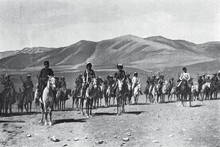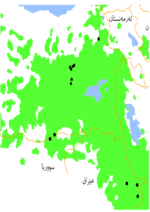Chechen Kurds
Chechen Kurds or Kurdified Chechens refer to the ethnic Chechens who went through a process of Kurdification[6][7] after fleeing to Kurdistan during and after the Russian conquest of the Caucasus in the 1860s. Today, these Chechens are being perceived as being ethnic Kurds of the "Chechen tribe" and "Lezgî tribe" by themselves and the Kurds.[2]
 Hamidiye cavalry at Varto (1901) – Both Chechens and Kurds joined the cavalry. | |
| Regions with significant populations | |
|---|---|
| Following villages in Varto district:[1][2][3] Bağiçi (Çaharbur) Kayalık (Zirinik) Tepeköy (Tepe) Tescilsiz (Doğdap) Ulusırt (Aynan) Aydıngün (Şaşkan), Çöğürlü (Arinç) and Kıyıbaşı villages in Muş district[4] Kızıltepe[4][5] Saidsadiq District[6] | |
| Languages | |
| Kurdish (as mother tongue),[2] Turkish, Chechen[2] | |
| Religion | |
| Hanafi[3] and Shafi‘i Islam[2] |
Chechen families were first settled in other regions of the Ottoman Empire like the Balkans, but were since moved to Kurdistan by the Sublime Porte.[8] The Ottomans planted Chechen refugees in Kurdistan and Western Armenia to change the demographics, since they feared Armenian separatism and, later on, Kurdish separatism.[9] The Chechen refugees intermingled with both the local Armenian and Kurdish population, but since the Armenian genocide resulted in the perishment of Armenians from the region, the Chechens only went through Kurdification.
Today, the Chechen population in Turkish Kurdistan is scattered among the Kurdish population and has been assimilated into it.[10]
About 200 to 300 Kurdified Chechen families live in Saidsadiq District, some 100 families in Penjwen District and about 200 in Sulaymaniyah city in Iraqi Kurdistan.[6]

Square mark: Majority
Circle mark: Minority
History
Migration to Kurdistan
As the first migration wave occurred in the late 1850s, Ottoman authorities managed to direct the refugees towards the Balkans, Western-, and Central Anatolia, since Russia warned the Ottomans not to settle them near the Russian border. The reasons none were settled in Kurdistan were due to the extreme poverty and the lack of materials needed for a settlement. Nevertheless, some migrants settled around Sarıkamış and founded about 20 villages on land previously owned by Armenians and Greeks. Chechen refugees preferred the mountainous region of Eastern Anatolia including Kurdistan, due to its resemblance to North Caucasus and in the early 1860s about 6,000 to 8,000 Caucasian refugees including Chechens settled in Sarıkamış. In 1865, the Ottoman authorities planned on settling 5,000 to 6,000 Chechen refugees in the Turkish-majority town of Çıldır, but the Russians opposed as it was too close to the front. As a result, most of them were settled southward in the unofficial Kurdish capital of Diyarbakir and Ras al-Ayn in present-day Syria. Between 1901 and 1905, Chechen refugees settled in the Kurdish towns of Varto and Bulanık since other ethnic groups like Circassians had already settled there.[8] No exact numbers exist for the number Chechens in Kurdistan, but the Jordanian Circassian author Amjad Jaimoukha estimates that 80,000 Chechens left for the Ottoman Empire in 1860 and 23,000 in 1865, however this number seems highly overestimated in retrospect when looking at the number of the Chechen diaspora in the former Ottoman empire today.[11]
Later history
When H. F. B. Lynch visited Eastern Anatolia in 1901, he wrote that the Circassians (referring to Chechens)[8] wore traditional clothings and that their living standards were far better than that of their Armenian and Kurdish neighbours.[12] In 1925, the Kurds of the newly proclaimed Republic of Turkey staged a rebellion led by Sheikh Said. Some local Chechens supported the rebellion[13] while others actively worked to constrain it.[14]
While it was already reported by Kurdish writer Mehmet Şerif Fırat, in his description of Varto in 1948 that the local Chechens there had forgotten the Chechen language,[3] the Turkish state claimed in a secret report in 1987 that the Chechens spoke Kurdish as their mother tongue.[2]
Villages and politics in Turkish Kurdistan
| Province | Tribe, Population | Village | Ethnic composition | Political affiliation[15] |
|---|---|---|---|---|
| Muş Province | Lezgî tribe 641 (1987) |
Bağiçi (Çaharbur) | Kurdish-speaking Chechens[2] | HDP, 2015: 95,1% |
| Kayalık (Zirinik, Zırınge) | Kurdish-speaking Chechens[2] | HDP, 2015: 96,6% | ||
| Çeçen tribe 387 (1987) |
Tepeköy (Tepe) and Tescilsiz (Doğdap) hamlet | Kurdish-speaking Chechens[2] | HDP, 2015: 95,1% | |
| Ulusırt (Aynan) | Kurdish-speaking Chechens[2] | HDP, 2015: 94,6% | ||
| — | Kıyıbaşı | Mixed Kurdish and Chechen village[2][16] | HDP, 2015: 97,1% | |
| Çöğürlü (Arinç) | Mixed Kurdish, Chechen and Arab village | AKP, 2015: 52,5% HDP, 2015: 43,1% | ||
| Aydıngün (Şaşkan) hamlet of Serinova village | Mixed Kurdish and Chechen village[17] | HDP, 2015: 94,6% |
References
- Ahmet Öztürk, Serap Toprak (2018). "Kafkasya'dan muş yöresine göçler ve göçmenlerin iskânı". Selçuk Üniversitesi Türkiyat Araştırmaları Dergisi : Uluslararası Hakemli Dergi. Selçuk University. 43. ISSN 2458-9071.
- Aşiretler raporu (1st ed.). İstanbul: Kaynak Yayınları. 2000. ISBN 9753432208.
- Mehmet Şerif Fırat (1961). Doğu İlleri ve Varto Tarihi. Ankara. pp. 58–59.
- Tarık Cemal Kutlu (2005). Çeçen direniş tarihi. p. 332.
- Alican Baytekin (2004). Öteki Aleviler: Şare Ma. p. 29.
- "Iraqi Circassians (Chechens, Dagestanes, Adyghes)" (PDF). p. 13. Archived from the original (PDF) on 2016-03-05. Retrieved 28 May 2018.
- Ali Rıza Özdemir (2013). Kayıp Türkler (in Turkish). p. 39.
- "Some Notes on the Settlement of Northern Caucasians in Eastern Anatolia and Their Adaptation Problems (the Second Half of the XIXth Century - the Beginning of the XXth Century)". Journal of Asian History. 40 (1): 80–103. 2006.
- Klein, Janet (2011). The margins of empire Kurdish militias in the Ottoman tribal zone. Stanford, Calif.: Stanford University Press. ISBN 978-0804777759.
- "Hoşgörü köyü" (in Turkish). ufkumuzhaber. Retrieved 21 May 2018.
- Jaimoukha, Amjad (2004). The Chechens : a handbook. London: Routledge. p. 229. ISBN 9780415323284.
- H. F. B. Lynch (1901). Armenia, travels and studies. II. p. 331.
- "Kimse Şeyh Said'in davasını, İslam'dan başka yönlere çekmesin". Ilkha. 29 November 2013. Retrieved 21 May 2018.
- Bellaigue, Christopher de (2010). Rebel land unraveling the riddle of history in a Turkish town (1st American ed.). New York: Penguin Press. ISBN 978-1101196274.
- "Sandık Sonuçları - YSK" (in Turkish). Retrieved 28 May 2018.
- Koçkar & Koçkar. "Çeçen ve İnguş Halklarının Geleneksel Müzik ve Çalgılarına Genel Bir" (in Turkish): 16. Cite journal requires
|journal=(help) - "BDP'li Çeçen aday: Kürt Halkıyla mücadele etmekden gurur duyuyorum" (in Turkish). Retrieved 11 June 2018.